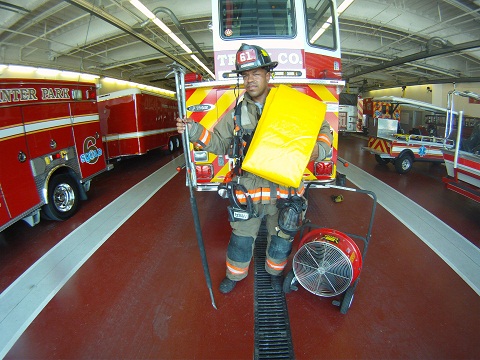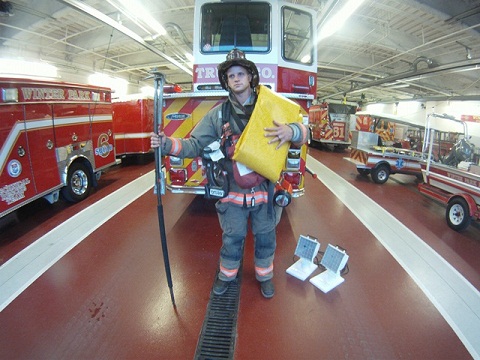In some of our recent posts we have been sharing thoughts on the benefit of riding assignments. Part 1 of the post can be found here and part 2 can be found here.
We will now continue the discussion and introduce the concepts of secondary functions and discuss how they can be utilized to increase your efficiency and effectiveness on the fireground.
The inside team’s primary functions are forcible entry, primary search, locating and confining the fire. After the fire is knocked down and the primary functions are complete, the inside team begins to switch its focus to salvage and overhaul.
The outside team’s duties vary greatly depending on the structure and scenario at hand. On residential structures, the outside team’s priority is going to be coming off the truck thinking VES until proven that all people are out of the fire building. If there is a sign of someone home or someone outside informing us that people are trapped then VES needs to be performed. If VES is not going to be a tactic used then the outside team moves down the “ prioritization list†of functions. As mentioned earlier, the prioritization list also changes based on the structure. For example, on a residential structure VES is the main priority whereas on a commercial structure Roof OPS are the priority. Obviously the “priority†tactic may be different for each department.
Once the outside team’s primary functions of VES, Secondary Egress, Ground Ladders, Roof OPS, Aerial OPS, and OVM (Outside Vent Man) are complete they will begin to transition to more “inside†duties. Regardless of where they are operating they will still maintain the radio designation of “outside truckâ€. Depending on timing, if the secondary search has not already been completed, the outside team will immediately perform the secondary search. Once all searches are clear and the primary functions are completed, the outside team will also transition into salvage and overhaul duties and assist the inside team. During the salvage and overhaul operation, the outside team sets up interior lighting, establish PPV fans if needed, and begins to monitor the interior air quality.
We understand that some of the specific functions listed might not apply to your situation due to staffing or departmental buy-in. The idea here is to simply “list†all of the main functions of your truck crew and come up with some sense of prioritization for them. Obviously these won’t work for every scenario and on every structure. Some situations may need all of the tasks done “at once†which will not allow for one crew to work down the list. The idea behind listing them out and prioritizing them is so everyone operating knows what to expect, and what jobs still need to be accomplished. Simply listing riding assignments down in some SOG, or posting them on a station board is not enough. Train until every member of your department is knowledgeable and proficient in relying on riding assignments.
Officer (Inside Truck 61): Radio designation of Truck 61
- Primary Functions: Forcible Entry, Primary Search, Locating the fire
- Secondary Functions: Overhaul
- Tools Carried: TIC (Thermal Image Camera), Hook, Halligan, Flashlight, or any other tools needed to accomplish task
- In large area buildings, i.e. large commercial space, consider large area search rope kit
Firefighter (Inside Truck 61): When working away from Truck 61’s Officer, radio designation becomes Truck 61 Irons
- Primary Functions: Forcible Entry, Primary Search, Locating and confining the fire (water can and/or closing fire room door)
- Secondary Functions: Overhaul
- Tools Carried: Irons, Water Can, Hook, Thru-the-Lock (Commercial Structures), Flashlight, or any other tools needed to accomplish task
- Thru-the-Lock tool on commercial structures, i.e. “A†or “K†tool for glass storefronts. Also consider the Hydro-RAM for apartments, college dorms, doctor offices, and hospitals
Driver (Outside Truck 61): When working on individual assignments, radio designation becomes Truck 61 Tractor
- Primary Functions: VES (Vent Enter Search), Force Rear Door (Secondary Egress), Ground Ladder OPS (Secondary Egress), Roof OPS, Aerial OPS
- Secondary Functions: Secondary Search, Salvage, Overhaul
- Tools Carried for Primary Functions: TIC (Thermal Image Camera), 6 foot Hook, Halligan, Ground Ladder, Flashlight, Saw (Roof OPS)
- Consider a Striking tool (i.e. PIG, Flat Head Axe, or Sledge) and Rotary Saw on commercial structures
- Consider longer hook based on structure (Roof OPS or high ceilings)
- Tools Carried for Secondary Functions: TIC (Thermal Image Camera), 6 foot Hook, Halligan, Flashlight, Salvage Tarps, Interior Lighting
Tillerman (Outside Truck 61): When working on individual assignments, radio designation becomes Truck 61 Tiller
- Primary Functions: VES (Vent Enter Search), OVM (Outside Vent Man), Ground Ladder OPS (Secondary Egress), Report fire conditions in the rear, Roof OPS
- Secondary Functions: Secondary Search, Salvage, Overhaul
- Tools Carried for Primary Functions: TIC (Thermal Image Camera), 6 foot Hook, Halligan, Ground Ladder, Flashlight, Saw (Roof OPS)
- Consider 55†Halligan Bar and Rotary Saw on commercial structures
- Consider longer hook based on structure (Roof OPS or high ceilings)
- Tools Carried for Secondary Functions: TIC (Thermal Image Camera), 6 foot Hook, Halligan, Flashlight, Salvage Tarps, PPV Fans, Gas Monitor



This information was helpful,Thanks!! ?